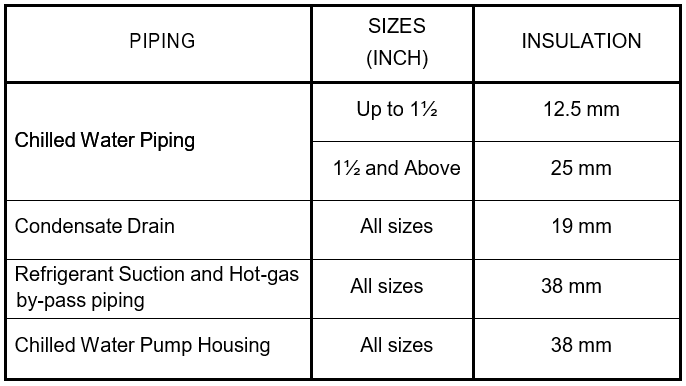12. Piping and Equipment Insulation
12.1 Piping Insulation
12.1.1 Refrigerant suction piping insulation shall be flexible elastomeric thermal insulation, closed-cell, sponge or expanded-rubber materials. Refrigerant suction piping insulation shall comply with ASTM C 534, Type 1 for tubular materials and Type II for sheet materials.
-
-
- Adhesive shall be as recommended by insulation material manufacturer
- Ultraviolet protective coating shall be as recommended by insulation manufacturer.
-
12.1.2 Refrigerant suction and hot gas bypass piping shall be routed from wall penetration to the air-cooled condensing units shall have aluminum metal jacketing. Aluminum jacketing shall be deep corrugated sheet manufactured from aluminum alloy complying with ASTM B209M.
12.1.3 Condensate drain piping insulation shall be flexible elastomeric thermal insulation, closed-cell, sponge or expanded-rubber materials. Refrigerant suction piping insulation shall comply with ASTM C 534, Type 1 for tubular materials and Type II for sheet materials. Adhesive shall be as recommended by manufacturer.
12.2 Chilled Water Pump Insulation
12.2.1 Chilled water piping insulation shall be cellular glass, inorganic, foamed or cellulated glass, annealed, rigid, hermetically sealed cells, incombustible complying with ASTM C552, Type 2. Insulation shall be provided with a vapor barrier. Aluminum metal jacketing shall be provided for outdoor piping and shall be deep corrugated sheet manufactured from aluminum alloy complying with ASTM B209M.
12.2.2 Chilled water pump insulation shall be mineral fiberboard thermal insulation with glass fibers bonded with a thermosetting resin. Insulation shall comply with ASTM C 612, Type IB, without facing and with all-service jacket manufactured from kraft paper, reinforcing scrim, aluminum foil, and vinyl film.
12.2.3 Mastics shall be as recommended but the manufacturer and shall be compatible with insulation, jackets and substrate.
12.3 Metal Pipe Covering, Adhesives, Tie Wires and Taps
12.3.1 Adhesives and insulation materials: Insulating material shall be non-combustible as defined in NFPA Standard 220 and shall have a composite fire and smoke hazard ratings maximum 25 for Flame Spread and 50 for Smoke Developed. Adhesives to be waterproof
12.4 Quality Assurance
12.4.1 Fire test characteristics shall be in accordance with the requirements of this section and ASTM 84.
12.5 Execution
12.5.1 Preparation:
-
-
- Insulation shall not be installed before piping and equipment has been tested and approved.
- Surfaces shall be clean and dry prior to installation. Insulation application shall be finished with systems at operating conditions.
-
12.5.2 Installation:
-
-
- Insulation shall be continuous through inside walls. Pipe penetrations shall be packed with fire-proof self-supporting insulation material, fully sealed.
- Fittings and valves shall be insulated. Unions, flexible connections and expansion joints shall not be insulated. Insulation shall be terminated neatly with mastic material troweled on bevel.
- Insulation shall be finished neatly at hangers, supports and other protrusion
- Insulation or cover seams shall be located in the least visible locations.
- Jackets shall be provided on exposed insulation throughout, including equipment room. Insulation located in crawl spaces, pipe shafts and suspended ceiling spaces shall not be considered exposed. Pre-sized paper shall be used under jackets at uneven insulated surfaces.
- Chilled water and hot water piping fittings and valves shall be covered with an equivalent thickness of insulation material. Open mesh glass cloth shall be sealed with vapor barrier seala Lap joints shall be sealed with 100 percent coverage of vapor barrier sealant and adhesive. Butt joints shall be sealed with 102 mm wide strips of vapor barrier cloth sealed with vapor barrier adhesive. Exposed fittings and valves shall be installed with hydraulic setting cement paste over insulation material before applying jacketing.
- Refrigerant suction and hot gas bypass piping fittings and valves shall be covered with and equivalent thickness of insulation material. Butt joints shall be sealed with 102 mm wide strips of vapor barrier sealed with vapor barrier adhesive.
-
(i) Metal jacketing on refrigerant suction piping shall be secured with stainless steel bands, 13 mm wide by 0.020 thick.
(ii) Three bands shall be used for each 915 mm section of jacketing. Jacketing for fittings shall be preformed bi-sectional or mitered pipe covering segments.
-
-
- Condensate drain piping: Fittings shall be insulated with equivalent thickness of insulation material and applied with edges tightly butted. Joints shall be sealed with vapor barrier tape or sealer.
- Separation of joints or cracking of insulation due to thermal movement or poor workmanship shall be repaired.
-
12.5.3 Insulation Thickness Schedule shall be as per Table VI.
Table VI – Pipe Insulation Thickness

Note: For conductivity values refer to ASHRAE 90.1 table 6.8.3B.